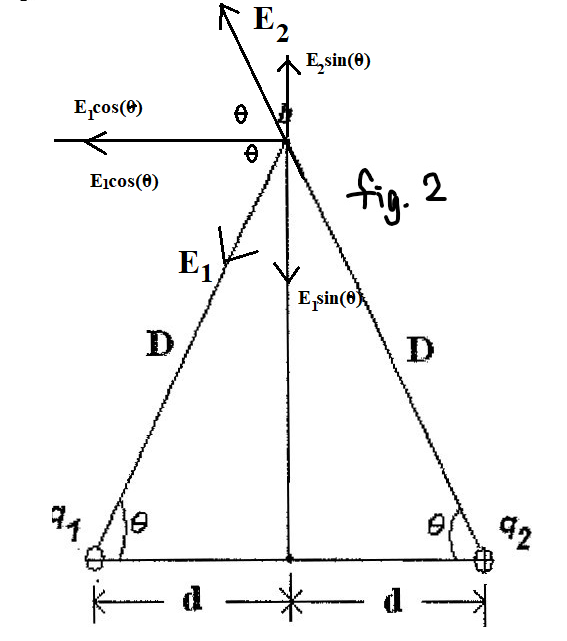proximate model of a water molecule. Point charges q1 and q2 of -1.00 x 10-19 C and 1.00 x 10-19 C, respectively, are placed 0.600 x 10-12 m apart. Thus d = 0.300 x 10-12 m in fig. 2 below, D= 0.600 x 10-12 m At point b, what must be the y-component Eynet of the net electric field due to the two charges? Show work. At point b, what is the x-component Exnet of the net electric field due to the two charges? At point b, what is the direction of the
proximate model of a water molecule. Point charges q1 and q2 of -1.00 x 10-19 C and 1.00 x 10-19 C, respectively, are placed 0.600 x 10-12 m apart. Thus d = 0.300 x 10-12 m in fig. 2 below, D= 0.600 x 10-12 m At point b, what must be the y-component Eynet of the net electric field due to the two charges? Show work. At point b, what is the x-component Exnet of the net electric field due to the two charges? At point b, what is the direction of the
College Physics
11th Edition
ISBN:9781305952300
Author:Raymond A. Serway, Chris Vuille
Publisher:Raymond A. Serway, Chris Vuille
Chapter1: Units, Trigonometry. And Vectors
Section: Chapter Questions
Problem 1CQ: Estimate the order of magnitude of the length, in meters, of each of the following; (a) a mouse, (b)...
Related questions
Question
This is an approximate model of a water molecule. Point charges q1 and q2 of -1.00 x 10-19 C and 1.00 x 10-19 C, respectively, are placed 0.600 x 10-12 m apart. Thus d = 0.300 x 10-12 m in fig. 2 below, D= 0.600 x 10-12 m
- At point b, what must be the y-component Eynet of the net electric field due to the two charges? Show work.
- At point b, what is the x-component Exnet of the net electric field due to the two charges?
- At point b, what is the direction of the net electric field due to the two charges? Indicate this direction by drawing an arrow in fig. 2 with its tail at point b.
- At point b, what is the magnitude of the net electric field due to the two charges? What is the relationship between your answer here and your answer to part (e)?

Transcribed Image Text:fig. 2
D
D
d --*
d
Expert Solution
Step 1
We see the two charges q1 and q2 and the point b is from the change is D the distance between the charge is also D is shown in the figure
here we see the figure which is given here, we draw a direction of the electric field by the charge q1 and charge q2 on the point b is shown as

Step by step
Solved in 4 steps with 1 images

Knowledge Booster
Learn more about
Need a deep-dive on the concept behind this application? Look no further. Learn more about this topic, physics and related others by exploring similar questions and additional content below.Recommended textbooks for you

College Physics
Physics
ISBN:
9781305952300
Author:
Raymond A. Serway, Chris Vuille
Publisher:
Cengage Learning

University Physics (14th Edition)
Physics
ISBN:
9780133969290
Author:
Hugh D. Young, Roger A. Freedman
Publisher:
PEARSON

Introduction To Quantum Mechanics
Physics
ISBN:
9781107189638
Author:
Griffiths, David J., Schroeter, Darrell F.
Publisher:
Cambridge University Press

College Physics
Physics
ISBN:
9781305952300
Author:
Raymond A. Serway, Chris Vuille
Publisher:
Cengage Learning

University Physics (14th Edition)
Physics
ISBN:
9780133969290
Author:
Hugh D. Young, Roger A. Freedman
Publisher:
PEARSON

Introduction To Quantum Mechanics
Physics
ISBN:
9781107189638
Author:
Griffiths, David J., Schroeter, Darrell F.
Publisher:
Cambridge University Press

Physics for Scientists and Engineers
Physics
ISBN:
9781337553278
Author:
Raymond A. Serway, John W. Jewett
Publisher:
Cengage Learning

Lecture- Tutorials for Introductory Astronomy
Physics
ISBN:
9780321820464
Author:
Edward E. Prather, Tim P. Slater, Jeff P. Adams, Gina Brissenden
Publisher:
Addison-Wesley

College Physics: A Strategic Approach (4th Editio…
Physics
ISBN:
9780134609034
Author:
Randall D. Knight (Professor Emeritus), Brian Jones, Stuart Field
Publisher:
PEARSON